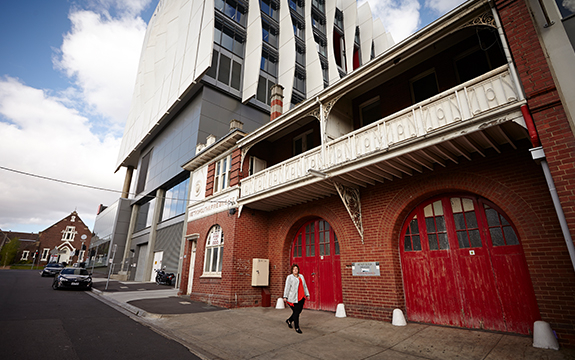Ideas and start-ups will form in future Innovation Precinct

In Summary
- This article originally featured in Swinburne’s Venture magazine
At Swinburne the entire university is the Innovation Precinct, and the fire station, off Burwood Road, is simply the front door.
A groundbreaking Swinburne project is coming to life behind the red brick façade of the old William Street fire station in Hawthorn. Swinburne’s initial $6.5-million investment in its Innovation Precinct will position the university as a centre of entrepreneurial activity, integrating research, new business development and commercialisation.
The plan for the Precinct, announced in March, will bring together Swinburne’s Design Factory Melbourne, its Digital Innovation Lab and its Factory of the Future, hosting events and workshops and providing opportunities for sharing ideas and expertise across diverse industries.
Professor Sally McArthur, its inaugural Director, says most universities promote some form of innovation centre on their campuses, but “at Swinburne the entire university is the Innovation Precinct, and the fire station, off Burwood Road, is simply the front door”.
“People and companies will be based in the fire station but the expertise extends beyond those walls: opening the university up and creating an imperative for people to come,” Professor McArthur says.
“The heritage of the building is another reminder that innovation isn’t new to Swinburne, but now we are bringing everyone together to ensure we get the best outcomes and impact for the problems we are solving for industry and community.”
Space to grow
When finished, the multistorey building will offer approximately 1000 square metres of space to students, staff, industry partners and start-ups. Within the Innovation Precinct, the Business Incubator will support at least 10 resident start-up companies each year, and the precinct will encourage connections as well as offering a new Innovation minor for students from any course at the university.
“We are quite serious about having all of our students involved – whether that is through extracurricular workshops, or though the new Innovation minor that will bring people from different disciplines together to learn more about ideation and innovation,” Professor McArthur says.
“We will also have a cycle of start-ups moving through our various accelerator and incubator programs, building our pipeline of exciting research translation and investment opportunities.”
Global vision
The value of innovation precincts, and their power in bringing academic, industry and community expertise together, is being increasingly recognised by universities in Australia and overseas. There has been a notable increase in developing them recently, although the Massachusetts Institute of Technology’s Kendall Square precinct was established in Boston as far back as the 1950s.
Kendall Square’s “anchor-plus” model is similar to Swinburne’s; it creates and establishes the space, leads the collaborations, and inspires a growth of start-ups and other businesses, either within or nearby. Innovation precincts create value for the anchor and its partners, and help to transform the local community and economy.
Thinking bigger
The precinct is one of the initiatives featured in the ambitious Swinburne University Research and Innovation Strategy 2020, launched in June 2016 by Deputy Vice- Chancellor Research and Development, Professor Aleksandar Subic.
“We are focused on lifting the level of research and innovation, thinking bigger, and opening our campus and our minds to partners and their needs,” Professor Subic says. “Our strategy is focused on real impact that transforms industries, shapes lives and communities. Impact is achieved outside of the boundaries of academia through collaboration with our partners, which is Swinburne’s core business.”
Swinburne is committed to creating a culture of innovation across its campuses, disciplines and research-led programs, “by creating an innovation ecosystem that engages students, staff, alumni, industry and business in diverse and seamless ways through co-location, innovation projects, joint ventures, start-ups, and other entrepreneurial schemes”, Professor Subic says.
Ready for action
Professor McArthur says a team of talented staff will help bring the precinct to life and plan the first rollout of activities. “It is a great opportunity and honour to lead the team bringing this to life – I’m proud that Swinburne University is bringing its innovation prowess to the next level,” she says.
While much will start to take shape in 2017, Professor McArthur says the university is ready to partner with industry.
“I think one of the most fantastic things about the Innovation Precinct is that although we have a vision for it, it is the people who come to collaborate from inside and outside the university who ultimately will shape what it becomes. How exciting is that?”

